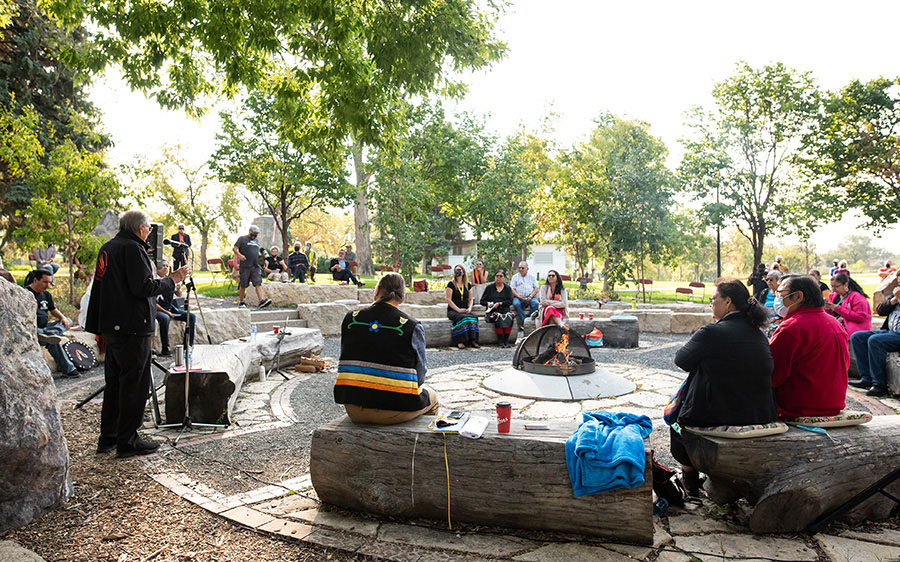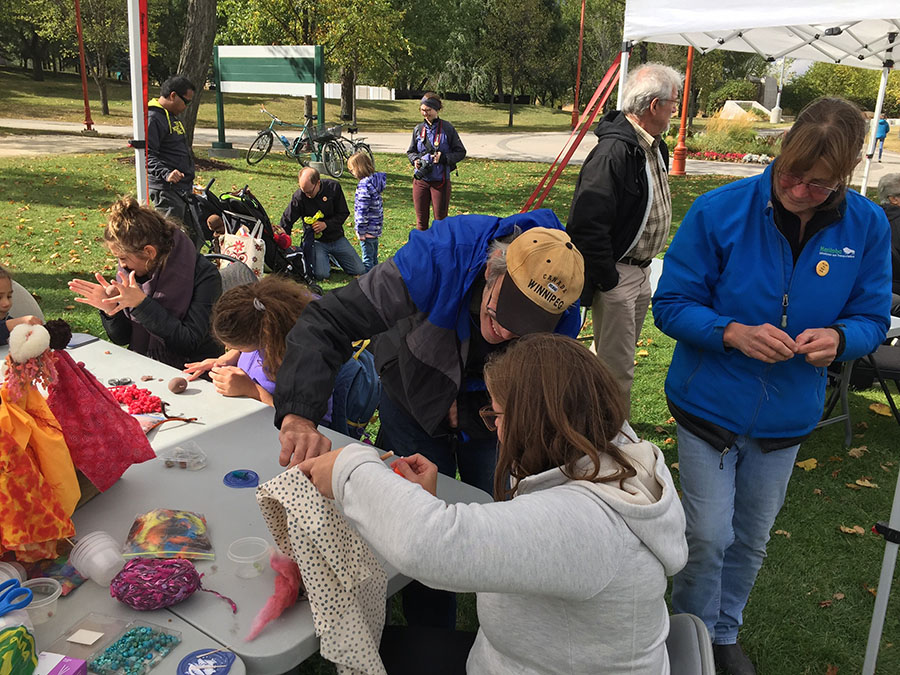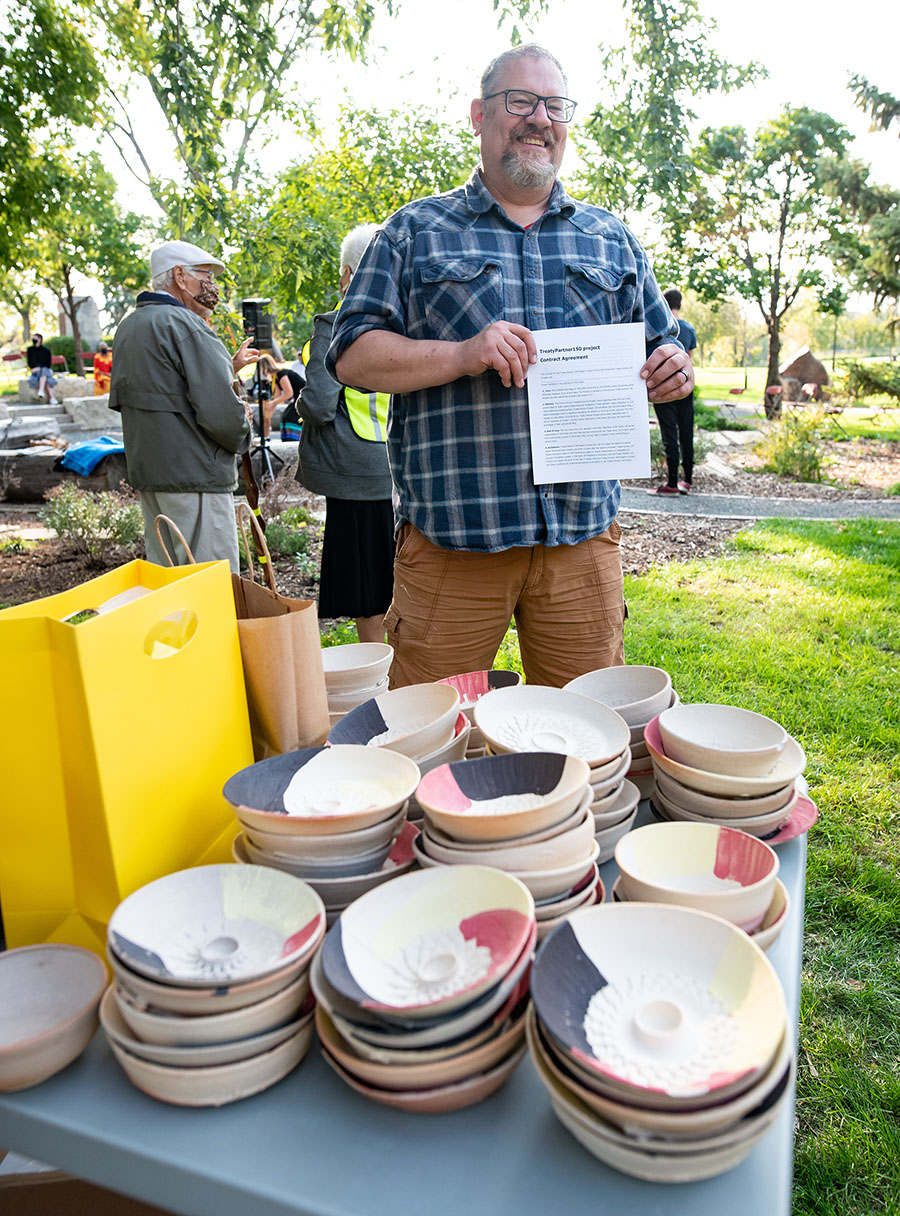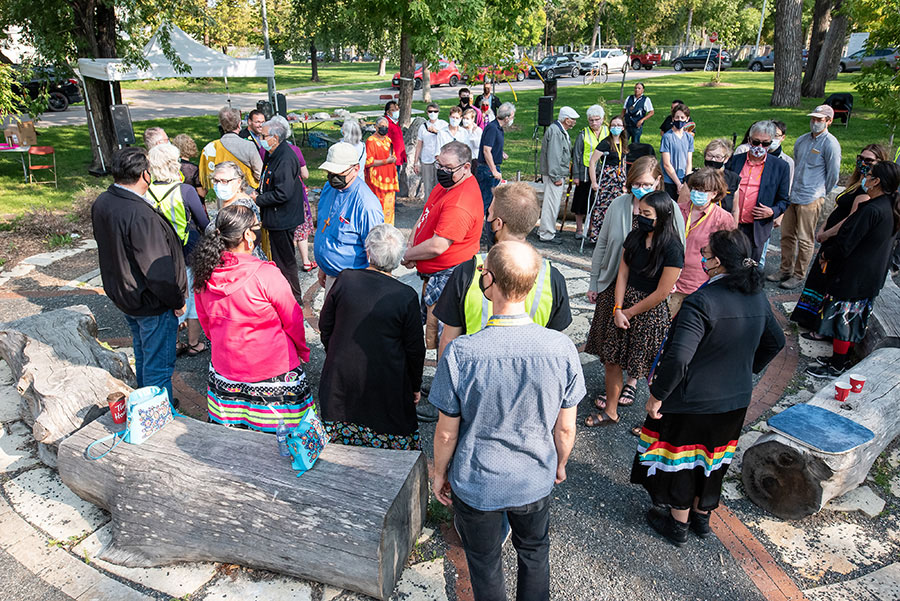Breathing Life Into Treaty Relationships
We arrived at 7 am. The autumn sun warmed the Kapabamayak Achaak Healing Forest in North End, Winnipeg, Treaty 1 territory. We came to set up. Something was planned that had not happened for 150 years. We gathered to commemorate the 1871 making and signing of Treaties 1 and 2. As the sacred fire burned, we were renewing our commitments to being good Treaty partners.
What does it mean for a Settler or Newcomer to be a good Treaty partner? When I moved to Manitoba in 1957, no one talked about Treaty. I didn’t learn about being a Treaty partner in school. I returned to Winnipeg in 2004 with new eyes for relationships between Settler/Newcomers and Indigenous people. I had lived on the unceded land of the Lubicon Cree Nation. Working for them, I experienced duplicity in Canadian and provincial governments negotiating land rights conflicts. I experienced the power of Indigenous peoples from around the world in Geneva negotiating the United Nations Declaration on the Rights of Indigenous Peoples. I learned how much my people, Settler/Newcomers, need to change our relationships with Indigenous peoples. I needed to learn to be a good Treaty partner.
It was 2015. Canadians had just received the Truth and Reconciliation Commission’s report with its 94 Calls to Action. Some Winnipeg Quakers gathered in circle. We came to reflect on how we could respond. The speaker, an Indigenous leader with deep wisdom, was holding the circle for us. I heard this: “We [Indigenous] Treaty people, we celebrate Treaty each year. You Settler people, you don’t celebrate Treaty. You need to learn to, because you are Treaty people, too!”
What a challenge! Where to begin? We started exploring the idea. At an Indigenous learning circle we floated our idea to create a Settler-initiated Treaty celebration. Our Mennonite friends responded warmly: “You do the planning! We’ll bring the food!”
We learned during our first try that creating such an event needed more planning than we had imagined. We abandoned it because we needed more time. Yet we had created a vision. We wanted to honour our Treaty partnership by celebrating diverse cultures and sharing food. We wanted a safe place for Indigenous and Settler folks to gather and build relationships. The entertainment needed to be balanced between Indigenous and Settler/Newcomer performers. It must be family-friendly. We wanted to weave in learning about Treaty 1, its gifts to Settler and Newcomer peoples, and what it means to be Settler/Newcomer Treaty partners.
In 2017 we had our first We Are All Treaty People Celebration! The planning committee involved Mennonites and Presbyterians who shared the costs. We started work in January. We adopted the name from an education campaign of the Treaty Relations Commission of Manitoba (TRCM). We invited (and were thrilled) when the TRCM Treaty Commissioner accepted our invitation to speak! We chose a September date to not conflict with Indigenous Treaty days. We chose a site at The Forks, where the Assiniboine and Red Rivers meet.
On September 17, Quakers arrived mid-morning. We erected tents. We set up the sound system. The food arrived and the coffee was on. We had a large, grassy site. Our lead act, Don Amero, was a well-known Indigenous performer. We opened with a drum song, and an Elder’s prayer and teaching. Loretta Ross, the TRCM Treaty Commissioner, spoke. We hosted singers and men’s and women’s Morris dancers. We shared food. Around the edges of the site were Indigenous crafters, puppet and button making tables, and a tent for Indigenous storytelling. After the food was gone, and the site cleaned, the feedback was great! We needed to do this again.
Since then we’ve broadened representation on the planning committee, with the TRCM becoming active in the planning. Our own understandings of being Treaty partners have deepened. In 2019 we created our vision statement:
To provide an opportunity for Settlers and Newcomers to join together with Indigenous people in celebrating the kinship relationship created by the signing of Treaty One (and other numbered treaties), to share the richness of these cultures through music and the arts, and to honour the treaty commitment to share this land together in a good way while acknowledging the pain caused by the many broken promises.
Kinship relationship: Treaty makes us relations! Aimée Craft’s book Breathing Life into the Stone Fort Treaty: an Anishinabe Understanding of Treaty One, describes Treaty as relationship based on respect, reciprocity, and renewal. This provides a guide to Settler/Newcomers about how to build Treaty kinship.
We continued through the pandemic, pivoting by broadcasting our event. This included a powerful conversation between Indigenous youth activist Michael Redhead Champagne, our MC, and Loretta Ross.
We knew that 2021 needed to be special. It commemorated the 150th year since making and signing Treaties 1 and 2. In them, Indigenous peoples here agreed to share their land with Settlers and Newcomers.
We planned our usual celebration to be online, yet wanted more. We wanted ceremony on the land. We shared ideas with the TRCM Elders Circle. They took over planning. We raised more money than usual, including a grant from Canadian Friends Service Committee.
The TRCM invited the Indigenous participants. We invited the Settler/Newcomers. Modeled on 1871, this included the Lieutenant Governor. We prayed for good weather. COVID regulations for vaccine passports and masks were respected, especially to protect participating Elders.
The day arrived. We gathered in the circle of the Kapabamayak Achaak Healing Forest for a moving, spirit-filled time. Rock sentinels mark the Four Directions, each painted with the sacred animal of their direction. Elders opened, offering pipe and water ceremonies to begin in a good way.
MC Jim Compton of the TRCM read greetings from Lieutenant Governor Janice Filman. Harry Bone, chair of the TRCM Elders’ Circle, offered teachings on the meaning of Treaty. Then all Settler/Newcomer participants were invited to gather at one of the sentinels, the one close to them or the direction from which they or their ancestors travelled to Treaty 1 territory. I chose the east, the direction from England, my birth land. The Indigenous participants gathered inside the circle. We flowed into the circle from the Four Directions to the sounds of the drum—Settler faith leaders, youth, and Elders. We were warmly greeted by the circle of Indigenous people, leaders, Elders, and youth. It was a profound time of deep relationship.
We joked about merging as we’re taught to do in traffic, one after another, as Settlers entering from the Four Directions joined those already walking inside the circle, so laughter merged with tears. Gifts were offered to everyone. Quaker potter Keith Barber provided smudge bowls for every gift, created with local clay that he dug himself. The commemoration ended with a feast.
The original peoples of this land welcomed us. We are invited into Treaty relationship, respectfully sharing the gifts of the land, sharing responsibility for its care. Planning for We Are All Treaty People Celebration 2022 is well under way. Through celebrating together and annual renewal, we are breathing life into our Treaty relationships.
Elaine Bishop is a member of Winnipeg Monthly Meeting. She is a former coordinator of CFSC and currently an associate for both CFSC’s Indigenous rights and criminal justice work.
Additional photos

Elder Bone teaches on the meaning of Treaty to the 150th Commemoration of Treaties one and two. Photo credit: Duncan McNairnay

Eric Leach and Gwen Anderson of Winnipeg Quaker Meeting assist at the puppet making table at the 2017 We Are All Treaty People Celebration. Photo credit: Keith Barber

Keith Barber with smudge bowls for gift giveaway. Photo Credit: Duncan McNairnay
Video of the We Are All Treaty People Celebration in 2021:
